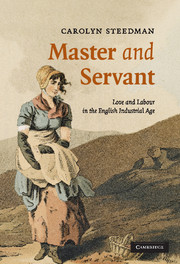Book contents
- Frontmatter
- Contents
- List of maps
- Acknowledgements
- Map 1 Map of the Haworth, Slaithwaite, Huddersfield and Halifax region, 1795
- Map 2 Sketch map of the woollen and worsted producing areas of the West Riding, late eighteenth century
- Prologue
- 1 Introduction: on service and silences
- 2 Wool, worsted and the working class: myths of origin
- 3 Lives and writing
- 4 Labour
- 5 Working for a living
- 6 Teaching
- 7 Relations
- 8 The Gods
- 9 Love
- 10 Nelly's version
- 11 Conclusion: Phoebe in Arcadia
- Bibliography
- Index
7 - Relations
Published online by Cambridge University Press: 06 January 2010
- Frontmatter
- Contents
- List of maps
- Acknowledgements
- Map 1 Map of the Haworth, Slaithwaite, Huddersfield and Halifax region, 1795
- Map 2 Sketch map of the woollen and worsted producing areas of the West Riding, late eighteenth century
- Prologue
- 1 Introduction: on service and silences
- 2 Wool, worsted and the working class: myths of origin
- 3 Lives and writing
- 4 Labour
- 5 Working for a living
- 6 Teaching
- 7 Relations
- 8 The Gods
- 9 Love
- 10 Nelly's version
- 11 Conclusion: Phoebe in Arcadia
- Bibliography
- Index
Summary
At the century's close, it was still the law that provided the major means for an employer's understanding of what kind of relationship that of master and servant actually was. Indeed, quite recent common law judgment had reformulated the relationship in consideration of pregnant maidservants like Phoebe Beatson. We need the story of this judgment in order to understand the true unusualness of Murgatroyd's behaviour from the end of 1801 until his death in 1806, for in 1777 the Lord Chief Justice, William Mansfield, had found a domestic servant's being with child cause for her lawful dismissal. In February of that year Lord Mansfield and his fellow judges heard the case of Rex v. the Inhabitants of Brampton in Derbyshire. It was a poor law settlement case that had come to King's Bench on appeal. In 1776 Hannah Wright had been removed on the order of two justices from Ashover to Brampton, both of them Derbyshire parishes. Brampton parish had appealed to quarter sessions, where the removal order was confirmed by the magistrates, because Hannah Wright had earned her legal settlement there through a year's hiring and wage-earning. This settlement in Brampton was not really in question, but rather whether or not it might have been superseded by one worked for at Eyam, another Derbyshire village some 15 miles west of Brampton along the Chapel-en-le-Frith road.
- Type
- Chapter
- Information
- Master and ServantLove and Labour in the English Industrial Age, pp. 131 - 151Publisher: Cambridge University PressPrint publication year: 2007

